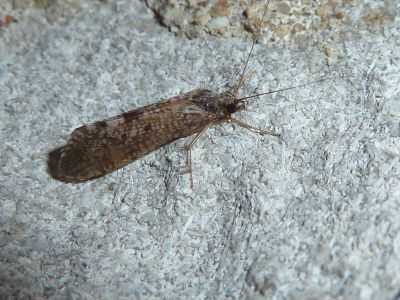
Good Natured: The Caddisflies
Anyone who's spent time along the Fox River, either in it, near it or even just driving past, will be familiar with the phenomenon known as the River Bugs. At various times throughout the warm weather months, these insects emerge from the water en masse and flutter about in dense mating swarms.
Today and over the next couple of weeks, we're going to explore this seasonal wonder, starting with the most common River Bug of all, the caddisflies. Small, brown and slightly fuzzy, these little bugs sometimes are regarded as nothing more than a nuisance. But as we'll see, these and other River Bugs serve as indicators of something we, too, need to survive: clean water.
Caddisflies belong to the order Trichoptera, or “hairy wings." North America is home to more than 1,300 species of caddisflies, a fact that may come as a surprise to casual river observers but not the legions of fly fisher-people who go to great lengths to create lures that replicate the intricacies of the caddis form.
The caddis are key members of aquatic food chains, feeding fish and other life forms in stream systems around the world. But their allure extends above the water's surface too. Purple martins, swallows (barn, cliff, bank, tree and rough-winged, to name a few), chimney swifts and night hawks are a few of the birds that partake of summer's periodic caddisfly feasts. Bats (big brown, little brown and red to, again, name a few) as well as hundreds of species of spiders and other predacious arthropods come flying, scurrying and scuttling in to take advantage of the caddisfly gravy train.
But what, exactly, is a caddisfly?
The order gets its common name from the Middle English word caddice, which means a woolen braid, ribbon, or tape. Way back when, caddice men used to display these wares by pinning them on their coats—much the same way adult caddisflies perch on clothing and other vertical surfaces.
Even though they are by nature aquatic, caddisflies are close relatives of the Lepidopterans, or scaly wings--the critters most people refer to as butterflies and moths. Both orders of insects have a larval phase in their life cycle, and both types of larvae pupate and emerge as winged adults. However, young caddisflies pass the days of their youth in the water, not on land.
The caddisflies we see along the Fox appear as part of synchronous “hatches," or emergences. Millions of newly minted adults come from the water within days of each other, ready to complete the last-- and shortest--phase of a life cycle that began about a year ago.
Back then, mated females deposited eggs in the water that soon hatched into larvae. Over the ensuing months the young insects grew through four immature stages called instars. Wriggly and green, they look very much like caterpillars as they cling to submerged rocks and logs and fed on leaf litter and vegetation.
In preparation for their leap into adulthood, the larvae spin small silken cocoons—similar to those of their land-dwelling cousins, but underwater—and begin their magical transformation from wiggly youngsters into winged adults. Complex cues then prompt them to emerge all at once, a strategy that not only aids survival of the species (predators can eat some, or most, but never all of a synchronous emergence) but also makes it pretty easy to find a mate.
Even with an abundance of options, adult caddisflies resort to speed dating. At this point, they've got maybe 10 days to two weeks left--just enough time to get down to business and reproduce. As the last adults of this emergence fade away, the new larvae of the next generation will be starting appear, and the cycle will begin again.
Some caddisfly larvae are free living but others are casebuilders that construct tiny houses out of rocks and sand or, in some species, plant material, which is held together with sticky silk.
Caddisflies' fascinating ways have inspired many who have observed them. Poets pen verses about them; artists create sculptures based on caddis larvae cases. And at least one enterprising entomologist/jeweler has gone into business. Wildscape Inc. (www.wildscape.com) sells earrings, necklaces, bracelets and the like featuring caddis cases made from precious stones.
We'll likely have more caddisfly emergences before the summer is over. If you're looking for a little inspiration yourself, head down to the river on the warm summer night and watch for clouds of brown insects around the street lights.
Watch for me, too. I'll be the one wearing the caddis-case earrings.
Next week: The Mayflies.
Pam Otto is the outreach ambassador for the St. Charles Park District. She can be reached at potto@stcparks.org.

